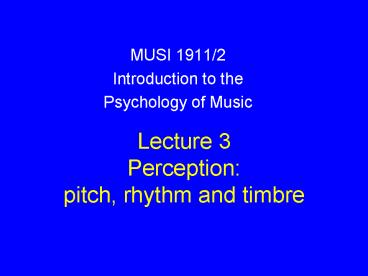Lecture 3 Perception: pitch, rhythm and timbre - PowerPoint PPT Presentation
1 / 15
Title:
Lecture 3 Perception: pitch, rhythm and timbre
Description:
pitch is that auditory attribute of sound according to which sounds can be ... BUT relationships between pitches are more than just one-dimensional ... – PowerPoint PPT presentation
Number of Views:98
Avg rating:3.0/5.0
Title: Lecture 3 Perception: pitch, rhythm and timbre
1
Lecture 3Perception pitch, rhythm and timbre
- MUSI 1911/2
- Introduction to the
- Psychology of Music
2
Overview
- Music Perception
- The notion of musical parameters pitch, rhythm
and timbre - 3 Examples of perceptual experiments
- Perception, representation and responses
- Shortcomings and biases
- Summary
3
Music Perception
- The study of how we organise musical sounds e.g.
- we hear pitch (not frequency)
- we hear relationships between pitches
- melody
- intervals between pitches
- harmonic relationships (tonality)
- What processes lead to such organisation?
4
The notion of musical parameters
- Pitch
- Rhythm
- Timbre
- Separate dimensions of music
5
Pitch
- pitch is that auditory attribute of sound
according to which sounds can be ordered on a
scale from low to high (ANSI) - BUT relationships between pitches are more than
just one-dimensional - octave equivalence (all As are equal)
- more dimensions?
6
Rhythm
- Temporal Patterns
- succession (what order are these events in?)
- duration (how long is this event/these events?)
- grouping (where are the boundaries between groups
of successive events) - metre (is there a cyclic pattern of stronger
and weaker events)
7
Timbre
- Timbre is that attribute of auditory sensation in
terms of which a listener can judge that two
sounds similarly presented and having the same
loudness and pitch are dissimilar. - American National Standards Institute (1960). USA
Standard Acoustical Terminology
(IncludingMechanical Shock and Vibration)
S1.1-1960 (R1976). New York American National
Standards Institute. - Timbre has always been the miscellaneous category
for describing the psychological attributes of
sound, gathering into one bundle whatever was
left over after pitch, loudness, and duration had
been accounted for. - Dowling, W. and Harwood, D. (1986). Music
Cognition. New York Academic Press.
8
- Different levels of timbral description
- 1. "the expressive variations
available to performing musicians" (45) - 2. "commonalities shared by all
oboe tones, all bowed violin tones, all timpani
tones, and so on (45) - 3. Broader family distinctions or
method-of-production distinctions "percussive
instruments, whose behavior is determined
completely at the instant when they are set into
motion, and instruments, such as blown and bowed
instruments, whose behavior is controlled
continuously. (45) - Krumhansl, C. (1989). Why is Timbre So Hard to
Understand? In S. Nielzen and O. Olsson (Eds.),
Structure and perception of Electroacoustic
Sound and Music, 43-53. Amsterdam Excerpta
Medica.
9
3 Examples of perceptual experiments
- Krumhansl and Shepard (1979)
- looked at perceived relationships between a scale
and subsequent probe pitches - Parncutt (1994)
- looked at the way in which we sense the pulse
of a musical rhythm (experiments and a model) - Grey (1976)
- looked at perceived similarity between
instrumental tones at the same pitch
10
Krumhansl and Shepard (1979)
- Materials (Exp. 1)
- Subjects listened to context (scale) followed
by a probe tone a single pitch - Probe tones were all the chromatic notes between
middle C and C an octave up - Contexts were ascending or descending C major
scale (below or above the range of the probes) - Task
- Rate how well the last tone completed the
sequence on a scale of 1 - 7
11
- Results
- Group 1 listeners
- Cs rated highly (no difference)
- Notes of tonic triad rated slightly less highly
- Notes in-scale fit better than non-scale notes
- Group 2 listeners
- Cs rated highly (small difference)
- Group 3 listeners
- Cs rated differently (by literal pitch distance)
- Subject 24
- Like group 1 only more so
12
- Conclusions
- there is a hierarchy of pitches for tonal music
- some people have internalised this hierarchy
better than others (representation) - perception is related to internal representations
of relationships between events - it is this representation (or schema) which is
hierarchical - we hear the same pitches, but perceive them
differently
13
Perception, representation and responses
- Researchers often attempt to show a clear
relationship between a perceptual task and a
mental representation or process - It is often assumed that we need to understand
perceptual processes and representations before
dealing with responses to music (such as
emotional ones)
14
Shortcomings and biases
- Much perceptual work focuses on tonal western art
music (or patterns that resemble it) - Little work looks at relationships between pitch,
rhythm and/or timbre - Many tasks still far from real musical situations
and events
15
Summary
- Perception
- the first stage in apprehending musical
structures - related to mental structures
- precedes emotional or other responses
- often studied using controlled experiments
- often musical parameters are isolated in rather
artificial ways































